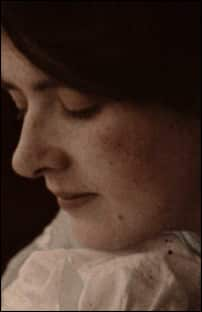Victorian domestic specialization and gender roles
By Kristopher A. Nelson
in
May 2016
600 words / 3 min.
Tweet
Share
As the Victorian version of separate spheres solidified in the mid-nineteenth century, the “idea of wifely sainthood gained ever more credence as housewives found themselves increasingly isolated from the male-operated world.”

Please note that this post is from 2016. Evaluate with care and in light of later events.
In a response to the common fact that young mothers so often died — through disease but especially in childbirth — the Victorians developed “what amounted to a dead-mother cult.”1 Though the scale of death of mothers was not radically different than in prior centuries, the impact on Victorian families appears to have been greater than in previous generations, due to factors like the hyper-specialization of gender roles and the lack of community cohesiveness combined with reduced numbers of extended-family connections in an increasingly mobile and urbanizing American society.
That is, husbands worked outside the home, while wives managed all household duties. Such an arrangement departed from the mixed roles of earlier generations. Families running small farms in rural areas, especially ones focused on subsistence agriculture typically put everyone to work without overspecialization based on gender. Similarly, earlier businesses in more urbanized areas were typically home-based, with both husbands and wives collaborating on business matters.2 “The home,” writes Ogden, “became a sanctuary, a sharp contrast with the [earlier] notions of home as service cooperate or display case.”3
Meanwhile, the American landscape was becoming increasingly industrialized and urbanized after the Civil War. Individuals and families moved seeking work; kinship and friend-based networks became stretched and thin as a result.4 The telegraph and railroads did more to enable this movement and disruption, even if they, along with the increasingly sophisticated postal system, enabled more effective long-distance relationships.
As the Victorian version of separate spheres solidified in the mid-nineteenth century, the “idea of wifely sainthood gained ever more credence as housewives found themselves increasingly isolated from the male-operated world.”5 This “cult of domesticity,” reinforced by the sanctification of dead mothers, became particularly important to women of the time as they realized that “wife- and motherhood represented their last remaining stronghold over men.”6
This American Victorian version of the public/private distinction thus developed in the late nineteenth century in reaction to a society altered by social and techno-industrial changes. The deepening division between male and female spheres, and especially the sanctification of the domestic home, connected to already existing and deep-rooted conceptions in American law, roots that precede the founding of the country, in fact. But this newer, stricter division, and its sacred family home, did not end with Queen Victoria: perhaps ironically, it became foundational for the twentieth century’s “right to privacy” as expressed in Griswold and Roe, for example.
- Annegret S. Ogden, The Great American Housewife: From Helpmate to Wage Earner, 1776-1986, Contributions in Women’s Studies, no. 61 (Westport, Conn: Greenwood Press, 1986): 65. ↩
- Note that I am not claiming a lack of gender distinctions or specialization in past eras, only contrasting the mixing of roles and activities before the Victorian era with the rigid hierarchy established by the Victorians (which itself was never rigidly maintained, particularly once race and class are considered). ↩
- Ogden, The Great American Housewife, 67. ↩
- Immigration and colonial history also contributed to a less-connected society as compared to the deep history connecting individuals and families to each other in their original homes in Africa, Asia, Europe, and the rest of the Americas. ↩
- Ogden, The Great American Housewife, 65. ↩
- Ibid., 66. ↩